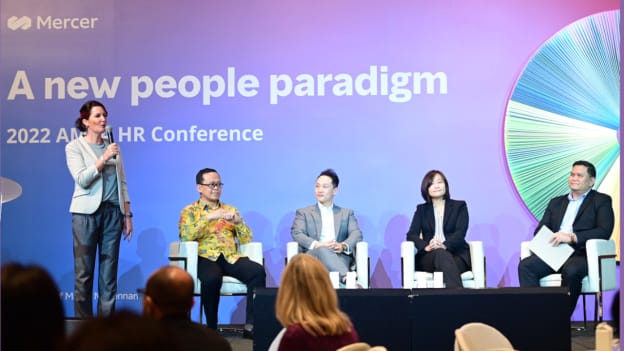Regional perspectives on engagement and retention

It's the perennial question these days: how do you create a stronger employee value proposition? How do you keep your people engaged, and keep them from leaving for another employe who looks better to them? Earlier this month, experts came together at Mercer's 2022 AMEA HR conference to share perspectives from around the region. Many of the themes that emerged are well-known by now – communication, customisation, career development, and more. But what's unique is how these play out in different countries.
In the Philippines, learn from the marketing experts
To attract talent, companies need a more differentiated EVP that covers aspects of acute interest to prospective employees, such as sustainability and lifelong learning, and HR practitioners put a great of time and effort into designing this. But not enough effort is going into communicating that polished EVP to candidates, said Sean Darilay, Talent Solutions Leader, Mercer Philippines.
“We need to be more awesome marketers,” he proposed. “We need to upskill ourselves and learn from our partners in the marketing and business functions, so that we can go to the market and say our organisation is irresistible.”
This approach can be applied to boost retention as well, he suggested, but in a more indirect way: employees who feel positive about their work are eight times more likely to stay with a company, and so organisations need to 'market' the successes of their employees through recognising and celebrating them. For example, he cited one company in the Philippines that uses digital platforms to reward employees for their engagement by giving them points that can be redeemed for gifts such as lifestyle items or practical needs such as travel insurance. “We need more ways to celebrate digitally and physically,” he commented.
In Indonesia, update employer branding
Isdar Andre Marwan, Commercial Director, Mercer Indonesia, shared several examples of how Indonesian companies have created very powerful employer brands. In one case, a company that received one of the highest scores in a survey on employer branding focuses on recognition, career, and religion: recognising employees for innovative ideas through a formal programme, offering employees opportunities to advance their careers by taking prestigious assignments with international partners, and even providing opportunities for hundreds of employees to go on haj every year – something which he noted can be very difficult for citizens of Indonesia.
In another example, he cited a startup – proving that employer branding is not just for large corporations – which emphasised four factors: firstly, a strong consumer branding position as a local brand; secondly, a strong social mission to help the lower income groups; thirdly, a policy allowing work from anywhere; and fourthly, encouraging its employees to exercise creativity and innovation.
In Thailand, customise all the way
“We have so many demographics in the workforce,” observed Kanyarat Chanyapunsab from Career Services, Mercer Thailand. “To attract talent I would propose a segmentation strategy, not just by generations but by job roles.”
The objective, she said, is to address attraction from a company-wide perspective: segmenting jobs into groups based on the value proposition of each role. That will make it possible to leverage data to create more customised experiences for each group and even each person, from goals to interactions and even the way the company communicates with the individual. It isn't even necessary to collect new data – companies can use the methods and data they already have on hand.
And the results can be surprising, she added: for example, people commonly assume that employees leave because of their managers. But when companies dig deep into the data, they sometimes find that there might be other critical factors, ranging from hybrid work to the employee's financial health and even their sense of security.
“Consider as well how we can understand the factors that are most critical for engaging our people in different segments, so that we can prioritise as well as create specific initiatives to engage our workforce,” she said.
In Malaysia, make employees your advocates
“Having word of mouth from your employees – where they willingly talk about what the company does for them in the short term and long term – really means a lot more in terms of the impact on attracting quality talent,” said Gim Soon Koay, Market Leader, Mercer Malaysia.
The corollary to that is, of course, that the company absolutely must communicate what it is doing, how it is prioritising actions that are meaningful and impactful to employees, and how it is following up over the long term – the next one year at the very least. That includes regular assessments to evaluate what improvements have actually resulted, he said.
“It's really about understanding our employees,” he added. “Understanding which life stage each category of employees has reached, and meeting the needs they have at that point in time. It's impactful for employees to know that their company actually took an interest in customising a package that works for them, and it's one of the more effective way that I've seen successfully demonstrated.”
The common factor: build, don't buy
Despite the varied areas of focus, all four experts touched on one common thing: there is a strong link between engagement and retention, and career development. This has several implications: firstly, companies will need to invest in technology at some point, specifically AI-driven learning management systems that can customise skilling for employees.
Secondly, companies will need to go the extra mile to enable learning and skilling, especially in fields where talent is rare. Isdar cited the example of an insurance company in Indonesia, where skilled and certified actuaries are hard to come by – this company, he said, would help its employees with all the necessary testing to get their certifications, from paying their fees, to providing a mentor and a study room in the workplace, to giving them special time off to prepare for examinations, and even paying a very hefty cash bonus for completing each certification.
Thirdly, talent building has to be an industry-wide effort.
“Buying talent solves short term issues but only drives up the market and creates significant additional costs for the same outcomes,” said Gim Soon. “Therefore, companies need to invest in developing people, upskilling and reskilling them to fit into the new working norm. And this needs to be a concerted approach by the whole industry or even the whole market to control costs.”
People Matters is the exclusive media partner for Mercer's 2022 AMEA HR Conference. Interested to participate in next year's edition of the conference? Check out this year’s agenda.















